ISSN ONLINE(2319-8753)PRINT(2347-6710)
ISSN ONLINE(2319-8753)PRINT(2347-6710)
Ankita Pritam Praharaj 1, Dibakar Behera 2, Tapan Kumar Bastia2
|
| Related article at Pubmed, Scholar Google |
Visit for more related articles at International Journal of Innovative Research in Science, Engineering and Technology
Due to the growing environmental awareness, societal concern and new environmental regulations, attention is currently being focused on natural fiber or “green” composites, composed of natural or synthetic resins and reinforced with natural fibers. Thus the present work aims at the fabrication of BisGMA (Bisphenol-A glycidyldimethacrylate) and randomly oriented amine functionalized paper pulp (10, 20, 30, 40 and 50 wt %) composites which are environmentally friendly. The mechanical properties of composites like Tensile Strength, Elongation at Break and Impact strength have been determined. Reinforcement of BisGMA by amine functionalized paper pulp resulted in a significant increase in all the above mentioned mechanical properties. Water absorption capacity of the composites is very low (0-1%) and composites are non corroded in saline environment. From the study of various mechanical, water absorption and corrosion properties, it can be concluded that the composites can be used in structural and automotive industries
Keywords |
| BisGMA, Paper pulp, Composite, Mechanical properties, Water absorption capacity, Corrosion test. |
INTRODUCTION |
| In recent years, the natural fibre reinforced composites have attracted substantial importance as a potential structural material. The attractive features of the natural fibres like jute [1,2], sisal [3], coir [4,5] and banana [6] have been their abundance, low cost, light weight, high specific modulus, renewability and biodegradability. Thus, composites reinforced with such natural fibres have thus been a subject of intense study for low strength, low cost application in contrast to the synthetic fibre reinforced composites which are non-biodegradable and pose environmental problems. A number of investigations have also been conducted on several types of natural fibers such as kenaf, hemp, bamboo and jute to study the effect of these fibers on the mechanical properties of composite materials [7-10]. Mansur and Aziz [11] studied bamboo-mesh reinforced cement composites and found that this reinforcing material could enhance the ductility and toughness of the cement matrix and increase significantly its tensile, flexural and impact strengths. On the other hand, jute fiber reinforced polyester composites were tested for the evaluation of mechanical properties and compared with wood composite [12], and it was found that the jute fiber composite has better strengths than wood composites. A pulp fiber reinforced thermoplastic composite was investigated and found to have a combination of stiffness increased by a factor of 5.2 and strength increased by a factor of 2.3 relative to the virgin polymer. Information on the usage of pulp fibers as reinforcement in thermosetting polymers is limited in the literature. |
| BisGMA resin is formed by the esterification of an epoxy resin with an unsaturated monocarboxylic acid such as acrylic or methacrylic acid (Figure 1). Now a day’s commercially available vinyl ester resin materials utilize BisGMA as major monomer in the resin. Polymer supports based on BisGMA are mainly used as excellent thermosetting adhesives. They have gained popularity owing to their superior performance in applications like binding of drugs and biomolecules. In electronic industries they are used as negative electron beam resists [13-15]. In leather industry they serve as primary material for the formulations of the base and topcoats [16, 17]. |
| In the present work, the authors have described the fabrication and mechanical properties of BisGMA composites reinforced with amine functionalized paper pulp. Here, the paper pulp acts as both filler and reinforcing fiber. In this work, BisGMA prepolymer is first synthesized by the reaction of bisphenol-A glycidylether with methacrylic acid and then the sample paper pulp is prepared in the laboratory using hot water and triethylene tetramine. Then BisGMA composites have been fabricated with different weight percents of paper pulp. The mechanical, corrosion and water absorption properties of the composites have also been studied to test the durability of composites. |
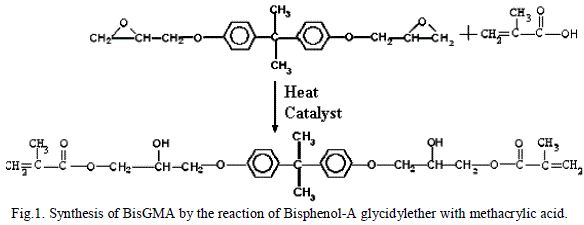 |
MATERIALS AND METHODS |
| (a) Raw Materials |
| Diglycidyl ether of bisphenol-A-type (DGEBA) epoxy resin and methacrylic acid were used for the synthesis of BisGMA [18]. Butylated hydroxytoluene (BHT) is used as a stabilizer and Triphenylphosphine (TPP) as catalyst. Triethylene tetramine (TETA) is also used for the preparation of sample paper pulp. Finally the prepared pulp samples were used with BisGMA for the fabrication of composites. All the chemicals were purchased from Sigma Aldrich. |
| (b)Synthesis of BisGMA |
| BisGMA was synthesized by the esterification of DGEBA with methacrylic acid (1:2) using BHT (0.03 wt %) as stabilizer and TPP (1 wt %) as catalyst. The temperature was raised to 90-950C and the reaction took 6 hrs for completion. |
| (c)Preparation of sample paper pulp |
| Sample paper pulp was prepared in our laboratory by treating waste newspaper with hot water and then with TETA. It was then used as reinforcement in the fabrication of BisGMA composites. |
| (d)Fabrication of Composites |
| The fabrication of the polymer composite was done at room temperature by using Hand-layup technique. At the beginning of fabrication, gel coat was uniformly brushed into the finished side of male and female parts of the mould. After 10 minutes, different weight percentage of amine treated paper pulp was pre-impregnated with matrix material (BisGMA). Then the mold was subjected to hot-press. The temperature was 800C for 6 hours and 1200C for 4 hours and pressure was 5 tons. After curing, the mold was opened, slab was taken out from the mold and cleaned. Finally the samples were taken out for different tests according to ASTM standard. The following nomenclature shown in Table 1 is used for identification of different composites. |
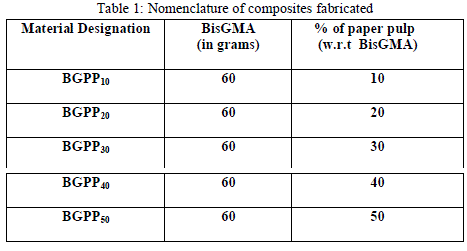 |
 |
| (e)Characterization of Composites |
| (i) Mechanical Properties |
| The specimen size used for all the mechanical testing was 12x10x3 mm3.The tensile test and elongation at break was conducted according to ASTM D790-03 standard. Both the tests were carried out using Instron universal testing machine model 3369.IZOD impact tests were conducted as per D256-05. Five specimens of each formulation were tested and average values were reported. |
| (ii)Corrosion test |
| For corrosion tests, three specimens (12x10x3 mm3 and exposed area of 372 mm 2 ) were tested according to ASTM B117 [19] standard. The tests were conducted by dipping the specimens in circulating salt water with 10% NaCl concentration and pH value of 6.5. The initial weights of the specimens were taken in dry condition in a 4-digit electronic balance. After a gap of 24, 48, 72 and 120 hrs of testing at a temperature around 42 0 C, the specimens were rinsed and cleaned in deionized water; dried and final weights were taken. |
| (iii)Moisture absorption test |
| Moisture absorption tests were conducted as per ASTM D570.The test specimens (25mm × 25mm) were cut from the laminates with edges of the samples sealed with BisGMA. The samples were pre-conditioned by drying in an oven for 24 hrs at 600C and weighing before being dipped in distilled water. Five specimens of each formulation were tested and the average values were reported. The samples were removed from the water at regular intervals and wiped with tissue paper to remove the excess fluid on the surface. An electronic balance of accuracy 0.00001 mg and model AY220 was used to measure the weight of samples in the moisture absorption test. |
RESULTS AND DISCUSSION |
| (a)Tensile Strength (TS) |
| Tensile strength is an important property of composites as it measures their brittleness. In the present work, it was found that the Tensile Strength of the above fabricated composites gradually increased with the addition of filler (paper pulp) (Figure 2), attained a maxima at 40 wt% of filler and then decreased. The reason for this behaviour is that as the filler content in the composite increases, the matrix becomes more and more dense which strengthens the composite enabling it to withstand stress efficiently. But at higher concentration, the filler is no longer able to mix thoroughly with the matrix which causes phase separation of the continuous and the dispersed phase. This results in the decrease in the toughness of the composites above 40 wt% due to which the values decrease. |
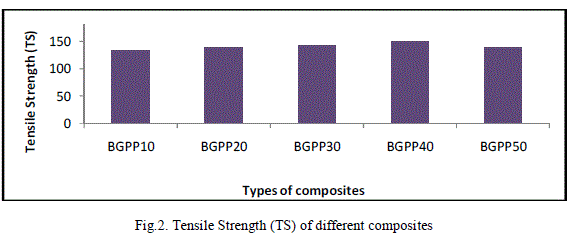 |
| (b)Elongation at Break (EB) |
| The values of elongation at break also showed similar results (Figure 3). The values increase till 40 wt% of filler content and above this, the values decrease. This can be attributed to the fact that low paper pulp content enables even distribution of filler particles in BisGMA matrix i.e. upto 40 wt% which prevents the composites from necking on application of stress. But beyond this, the amount of paper pulp present in the matrix increases which results in agglomeration of filler particles. This prevents the filler particles from mixing properly with the matrix. Thus, it remains as a distinct agglomerated phase which prevents the transfer of stress from the filler particles to the matrix. Due to this, the composites are unable to exhibit greater elongation at break at higher composition of paper pulp. |
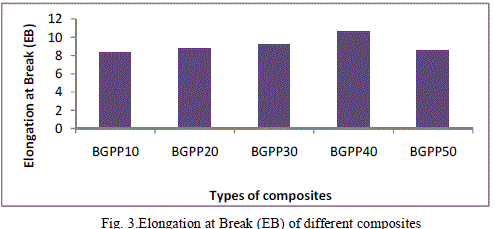 |
| (c)Impact Strength |
| It is interesting to note that along with Tensile Strength and Elongation at Break, the Impact strength also shows a decreasing tendency with increased filler content i.e. above 40 wt% (Figure 4). Initially, the values increase with the addition of paper pulp. This is because the paper pulp acts as filler as well as a reinforcing fiber, which gives a strengthening effect to the matrix phase thereby improving all the mechanical properties including the impact strength. Thus, the composites do not easily get fractured on application of load. But as the filler content increases, the filler particles get accumulated at one place and are not able to mix thoroughly with the matrix phase. As a result of this agglomeration, phase separation takes place which gradually deteriorates the mechanical properties above 40 wt% composition. This deterioration continues as long as the paper pulp content is increased. Here, we have shown the results up to the 50 wt%, to emphasize on the important experimental results only. |
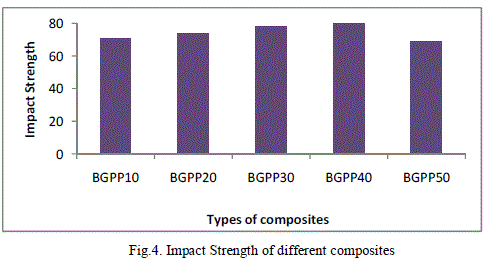 |
| (d)Corrosion test |
| The weight losses or the weight gains are noted for plotting various graphs as shown in Figure 5. It is observed that weight gains refer to oxidation and losses confirm reduction. In all the cases (BGPP10, BGPP20, BGPP30, BGPP40, BGPP50), oxidation takes place. But the composites with low filler content show less weight change as compared to the composites with high filler content. This is because in composites having low filler content i.e. up to 40 wt%, the surface is smooth due to the filling effect of filler. This prevents the formation of voids and microcracks on the composite surface. As a result the absorption of salt water by the composites decreases resulting in less weight change. But at higher compositions, the agglomeration of filler particles leaves the composite surface rough resulting in the formation of a number of voids. This enhances the diffusion of salt water into the matrix phase through the voids formed which increases the weight change in the composites. This also results in the decrease of mechanical properties of composites having filler content above 40 wt% .The least weight change is observed in the case of composite having 40 wt% filler content which is also responsible for the maximum improvement in its mechanical properties. |
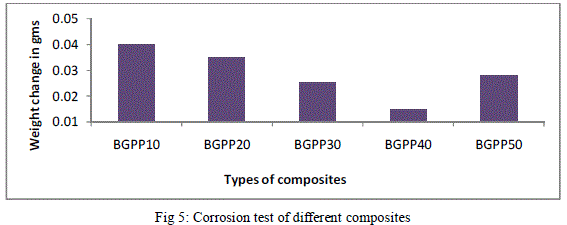 |
| (e)Moisture absorption test |
| Moisture absorption of the composites would lead to swelling and degradation which may result in poor mechanical properties and dimensional instability. Thus, the water absorption capacity of the composites was evaluated to find out whether they could be used in structural applications. The moisture absorption capacity for paper pulp reinforced composites has been evaluated by dipping the composites in water for 120 hours. After that, the weight of treated and untreated composites before and after treatment is taken in to consideration for testing their hydrophilic nature. The results are shown in Figure 6. |
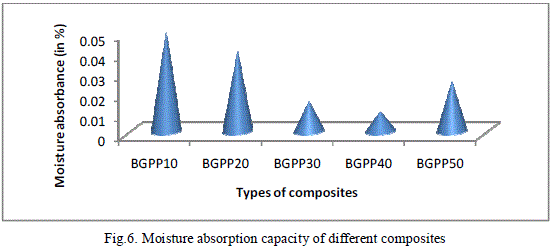 |
| From the results it is concluded that the composites with less content of filler absorb less moisture as compared to the composites with higher filler content. This is because phase separation of the matrix and the dispersed phase that takes place at higher filler content (50 wt%) results in the formation of rough topography in the form of voids on the composite surface. These voids result in easy diffusion of water inside which weakens the interfacial bonding between BisGMA and paper pulp. The high water uptake also weakens the composites mechanically. But at low filler content the well dispersed filler particles in the matrix result in a much smooth surface which prevents diffusion of water into the composite surface. Moreover, the BGPP40 shows least moisture absorption due to the advantage that it gets from the right amount of filler and fiber. |
CONCLUSION |
| In this work, we have fabricated and investigated the mechanical properties of BisGMA/Amine functionalized paper pulp composites. The corrosion and water absorption properties have also been investigated. It has been found that with increasing filler content, the mechanical, corrosive and water absorption properties of composites decrease due to the agglomeration of filler particles in the matrix phase. Thus, it can be stated that less filler content accounts for the proper mixing of filler in the matrix, showing a single phase system and absence of voids. This is responsible for the improvement of the mechanical, corrosive and water absorption properties of the composites with less filler content. Moreover, the BGPP40 shows the best results. Thus, it can be considered as the optimum composite composition that can be used for various structural and automotive applications. |
References |
|